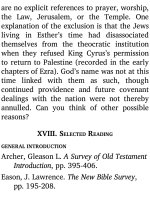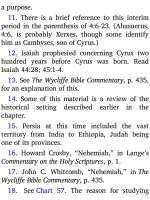Jensens survey of the old testament adam 194
Bạn đang xem bản rút gọn của tài liệu. Xem và tải ngay bản đầy đủ của tài liệu tại đây (117.46 KB, 4 trang )
sarcasm or irony to expose or rebuke actions
and attitudes. E.g., 40:19-20; 41:6-7; 44:1320.)
B. SIMILARITY OF OUTLINE
In character and broad outline, many of
Isaiah’s discourses are very similar. The
following four points can usually be seen in
such
discourses:
(1)
indictment
or
accusation; (2) threat; (3) exhortation or
entreaty; (4) promise of puri cation or
blessing.
The
rst discourse, chapter 1, is an
illustration of this:
1. The Indictment or Accusation (vv. 1-9)
2. The Threat (vv. 10-15)
3. The Exhortation or Entreaty (vv. 16-20)
4. The Promise of Puri cation and Blessing
(vv. 21-31)
C. SONGS IN ISAIAH
Although Isaiah is not a book of poetry,
various
songs
and
refrains
appear
throughout the book. Some of the more
prominent ones are:
1. Song of the Vineyard (chap. 5)
2. Song of the Redeemed (chap. 12)
3. Song of the Blossoming Desert (chap. 35)
4. Song of the Restored Wife (chap. 54)
IV. SURVEY
Follow the procedures of survey study
established in the earlier chapters of this
book. This includes scanning the entire book
of Isaiah and assigning a chapter title to
each of the sixty-six chapters. Compare the
opening and closing chapters. Look for
groupings of subject matter. Be alert to key
repeated words and phrases. Determine a
theme and title of the book.
Study carefully the survey Chart 81.
Observe that there are two main parts in the
book of Isaiah, the division coming between
chapters 39 and 40. Does this observation
agree with the overall patterns of your
chapter titles? On the survey chart the two
main divisions are identi ed as (1)
Judgment of God and (2) Comfort of God.
Think more about these two subjects as they
are discussed below.
(chaps. 1-39)
Judgment is the prominent thought of the
rst division of Isaiah—judgment on Judah
and Jerusalem for their sins, and judgment
on the nations which are hostile to the
chosen people. But although judgment is the
keynote of this rst division, scattered here
and there are promises for Judah, and hopes
for both Jew and Gentile, in the predictions
of the Messiah. Amid the darkness there are
A. JUDGMENT OF GOD
frequent
ashes of the “great light”
mentioned in 9:2; glimpses of the “bright
morning star” (see Rev 22:16), and the
coming Redeemer, of whom Isaiah speaks so
fully in the later chapters.
Looking more closely at the chapters, it is
convenient for study to subdivide this rst
division. For example, the chart shows that
the rst twelve chapters are discourses
addressed chie y to Judah and Jerusalem;
chapters 13-27 are discourses regarding the
nations which were hostile to Judah;
chapters 28-35, various warnings and
promises; and the last four chapters of the
section are purely historical, being a review
of Hezekiah’s reign, given in 2 Kings 18-20.
(Recall
from Chart 80 when Hezekiah
reigned as king.) Read in the Bible text each
of the sections just cited, and try to justify
the outlines shown on the chart.









